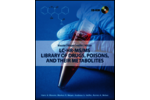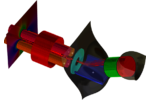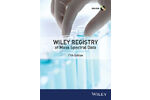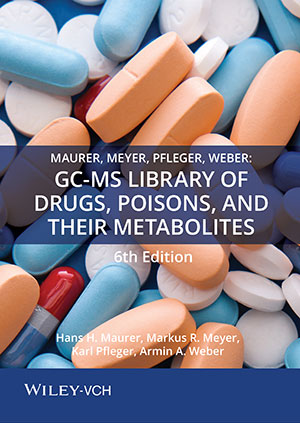Description
by Hans H. Maurer, Markus R. Meyer, Karl Pfleger, Armin A. Weber
The Essential Reference for Clinical and Forensic Toxicologists – Newly Updated!
The most comprehensive reference for clinical and forensic toxicologists has once more been extensively updated. The Maurer Meyer Pfleger Weber (MMPW) spectral database contains experimental data that are relevant to the analytical toxicologist. To aid in compound identification, all substances are classified according to their toxicological categories. Methods are now provided with the database in a convenient PDF format.
Developed and updated by the renowned toxicology group in Saarland, Hans H. Maurer, Markus Meyer, and Armin Weber, the Maurer, Meyer, Pfleger, Weber: GC-MS Library of Drugs, Poisons, and Their Metabolites 6th Edition is one of the most esteemed spectral databases for GC-MS identification and is globally recognized and relied upon by toxicologists, forensic scientists, coroners, and environmental chemists in the identification of drugs, poisons, and other toxins, and their metabolites.
This extensive spectral collection includes 10,948 high-quality mass spectra and GC retention indices with compounds from 175 categories including psychoactive substances, almost all relevant therapeutic drugs, and over 7,800 of their metabolites.
Available in the most common instrumentation manufacturer formats, this spectral library is a necessity for any laboratory engaged in the GC-MS analysis of drugs, poisons, and other toxins.
The previous edition of this database, Mass Spectral Library of Drugs, Poisons, Pesticides, Pollutants, and Their Metabolites, 5th Edition, is widely known as the Maurer Pfleger Weber (MPW).
Applications: The MMPW GC-MS library offers exceptional reliability as a comprehensive resource for compound identification, characterization, and data interpretation for the forensic and clinical toxicology laboratory. With the MMPW GC-MS library, forensic and clinical toxicologists have a powerful tool that enhances their laboratory capabilities for confident identification.
The world's most comprehensive reference for clinical and forensic toxicologists is keeping pace with recent developments in clinical and forensic toxicology in its new release to this gold standard, including novel therapeutics, designer drugs, herbal drugs, and a broad range of AIDS therapeutics, clinically relevant substances, and their metabolites.
Market
Toxicologists; Clinical Chemists; Environmental Chemists; -Spectroscopists; Forensic Scientists; Hospitals; Investigating Authorities -
Reviews from Previous Versions
"I strongly recommend these two volumes for libraries and for all the GC-MS users carrying out environmental, toxicological, clinical, and pharmacological studies." – Journal American Society for Mass Spectrometry, 2011
"An invaluable source of reference for anAy environmental, toxicological or analytical laboratory." – Rapid Communcations in MS
"The modern toxicological laboratory can ill afford to be without this unique work." – Veterinary Human Toxicology
Content Detail
Structure:
The formulas are redrawn in the molefile format allowing their use in electronic databases. They are zoomed to fit the available space. Formulas of metabolites or artifacts are those of their probable structures. If the position of a substituent is unknown, the substituent is fixed with a tilde. Unknown substituents are named "R".
Molecular mass:
The molecular masses were calculated from the atomic masses of the -most abundant isotopes.
Retention Index:
The RIs were measured by GC-MS on methyl silicone capillary columns -using a temperature program. The RIs of compounds with an asterisk (*) -are not detectable by nitrogen-selective flame-ionization detection (NFID).
Detected:
The compound could be detected in the given samples after the given sample preparation. These data have been evaluated from about 80000 clinical and forensic cases.
CAS Registry Number:
The Registry Number of the Chemical Abstracts Services (CAS) is given -here. If only derivatives or metabolites of a compound were included in -this handbook, the CAS number of the corresponding parent compound -with the prefix "#" is given.
Recorded from:
Type of sample from which the spectrum was recorded. If the spectrum -was recorded from samples of biological origin, it should be taken into -consideration that fragment ions from sample impurities may be present -in the spectrum. With experience, it is possible to decide whether these -ions can be ignored.
Categories:
The major pharmacological category is given. Additional information including abbreviations are given in the Print version.
Compound Names
The international non-proprietary names for drugs (INN), the common names for pesticides and the chemical names for chemicals are used. If necessary, a synonym index, should be consulted. If the compound is a common metabolite or derivative of several parent compounds, then all known parent compounds are given.
Statistics
Edition # Data Sets 6th edition 2023 10948 5th edition 2017 10430 4th edition 2011 8650 3rd edition 2007 7840 supplemental 2000 6700 2nd edition 1992 4700 1st edition 1985 1500 Compounds by class (stats from 2011): metabolites +5200 acetylated +3800 methylated +1500 trimethylsilylated +1200 triflouroacetylated +800 pentaflouroacetylated +500 heptaflourobutyrylated +500
Overlap Analysis
% unique in MFW 5th:
Wiley 11: 67%
NIST 14: 66%
Designer Drugs 2016: 68%
FFNSC 3: 98%
LMPEST2: 95%
Compound Classes (2007)
Acaricides, Alcohol deterrents, Alkaloids, Anabolics, Analgesics/Antiphlogistics, Deuterated Analytical standards, Androgens, Anesthetics, Anorectics, Anthelmintics, Antiamebics, Antiandrogens, Antiarrhythmics, Antibiotics, Anticholesteremics, Anticoagulants, Anticonvulsants, Antidepressants, Antidiabetics, Antidiarrheals, Antidotes, Antiemetics, Antiestrogens, Antifreezes (Glycols), Antihistamines, Antihypertensives, Antimalarials, Antimigraines, Antimycotics, Antineoplastics, Antioxidants, Antiparkinsonians, Antirheumatics, Antiseptics, Antispasmotics, Antitussives, Beta-Blockers, Biomolecules, Bronchodilators, Ca Antagonists, Chemicals, Coronary dilators, Corticoids, Counterirritant, Derivatizing agents, Dermatics, Designer drugs, Disinfectants, Diuretics, Emetics, Estrogens, Expectorants, Fatty acids, Flavors, Fungicides, Gestagens, Heat transfer agents, Herbicides, Hydrocarbons, Hypnotics, Ingredients of tar, Insecticides, Laxatives, Local anesthetics, Molluscicides, Muscle relaxants, Neuroleptics, Parasympatholytics, Parasympathomimetics, Pesticides, Plant ingredients, Plasticizers, Pollutants, Potent analgesics, Potent antitussives, Preservatives, Psychedelics, Refrigerants, Rodenticides, Rubber additives, Rubefacients, Scabicides, Sedatives, Serotonin antagonists, Softeners, Solvents, Stimulants, Sugars, Sugar alcohols, Sweeteners, Sympathomimetics, Thrombocyte aggregation, Thyreostatics, Toccolytics, Tranquilizers, Tuberculostatics, Uricosurics, Urinary antiseptics, UV Absorbers, Vasoconstrictors, Vasodilators, Virustatics, Vitamins.
About the Authors
Karl Pfleger was appointed head of the Department of Toxicology at the Saarland University in Homburg/Saar, Germany, in 1967. In the late 1970s he developed, together with his PhD student Hans H. Maurer, novel analysis procedures for identification and Quantification of drugs, poisons and their metabolites in body samples. they introduced mass spectrometry as the gold standard into clinical and forensic toxicology. In 1985, they published the first edition of their unique handbook of GC and MS data together with Armin A. Weber, who was and is responsible for all technical and software developments, including the mass spectral database that was developed from the printed collection. In 1987, Karl Pfleger received the Jean-Servais Stas Medal of the Gesellschaft fur Toxikologische und Forensische Chemie (GTFCh). In 1992, Karl Pfleger retired and Hans H. Maurer became his successor as professor and head of the department. His main areas of research are analytical t oxicology (GC-MS, LC-MS) and metabolism of xenobiotics. He has published over 130 original papers and 20 invited reviews. He has received several scientific awards, including the Young Investigator Award of the Homburg Medical Faculty in 1983, the Irving Sunshine Award for Outstanding Contributions to Clinical Toxicology of the International Association of Therapeutic Drug Monitoring and Clinical Toxicology (IATDMCT) in 1997, the Alan Curry Lifetime Achievement Award of The International Association of Forensic Toxicologists (TIAFT) for Outstanding Contributions to Forensic Toxicology in 2003, and the Doctor Honoris causa title of the University of Ghent in 2007. He is the current President of IATDMCT (since 2007), Councillor of TIAFT (since 2005) and treasurer of GTFCh (since 1987).
Supported Formats
Compatible with:
Agilent ChemStation/MassHunter/OpenLab (.L), NIST MS Search, PerkinElmer TurboMass, Shimadzu GC/MS Solutions, Thermo Xcalibur/TraceFinder/Chromeleon/Compound Discoverer, Waters MassLynx, ACD/Labs ACD/Spectrus, Bruker MS Workstation, Chromatec Analytic, Leco ChromaTOF, JEOL msFineAnalysis, Scion MS Workstation
| GC-MS Library of Drugs, Poisons, and Their Metabolites, 6th Edition, USB | |||
| Part No. | License | Price EA |
Order |
|---|---|---|---|
| 9783527352869 | New | $10494.00 | |
| 9783527352852 | Upgrade | $5576.00 | |
| * Standard lead-time for non-stock items is approximately two weeks depending on the item. | |||
|
|
|||
ISBN: 978-3-527-35286-9 (2023), 978-3-527-35285-2 (2023 upgrade) 978-3-527-34327-0 (2017), 978-3-527-34328-7 (2017 upgrade), 978-3-527-32398-2 (2011), 978-3-527-32399-9 (2011 upgrade), 9783527321469 / 9783527323289 / 9873527315383 (2007)
Also available: see our LC-MS/MS edition of this library.
 MMHW LC-HR-MS/MS Library of Drugs, Poisons, and Their Metabolites Description by Hans H. Maurer, Dirk K. Wissenbach, Armin A. Weber, 2019 Optimize your metabolite-based LC-MSn screening and minimize false negative results. The Maurer/Wissenbach/Weber LC-MSn Library of Drugs, Poisons, and Their Metabolites, Second Edition provides a proven metabolite-based LCMSn screening method and MS2 and MS3 spectra of over 2,270 parent compounds and over 3,600 of their metabolites, making it one of the only LC-MSn screening libraries that focuses on metabolite spectra. The...
MMHW LC-HR-MS/MS Library of Drugs, Poisons, and Their Metabolites Description by Hans H. Maurer, Dirk K. Wissenbach, Armin A. Weber, 2019 Optimize your metabolite-based LC-MSn screening and minimize false negative results. The Maurer/Wissenbach/Weber LC-MSn Library of Drugs, Poisons, and Their Metabolites, Second Edition provides a proven metabolite-based LCMSn screening method and MS2 and MS3 spectra of over 2,270 parent compounds and over 3,600 of their metabolites, making it one of the only LC-MSn screening libraries that focuses on metabolite spectra. The...





